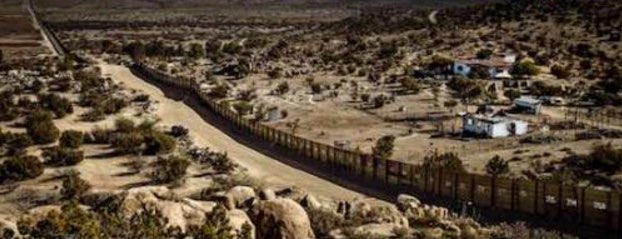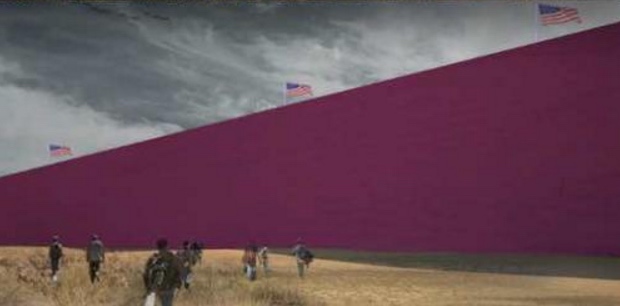With the signing of an executive order Wednesday, President Trump has begun to make good on his campaign promise to build a “big beautiful wall” along the as yet unwalled parts of the border with Mexico. But this epic project, which could cost as much as $25 billion according to some reports, is being put in the wrong location and, in any case, will be a complete waste of money anyhow in terms of deterring illegal immigration.
As the Manchus famously proved in the case of China’s laughably ineffective Great Wall, a wall, while perhaps a great tourist attraction, is only as strong as the people behind it. After multiple successful raids across the wall, a Manchu army poured through a fortified gate, not by breaking it down but by convincing and bribing a rebel Ming warlord to open it for them so they could march on Beijing and finish off the Ming dynasty, establishing the Qing dynasty that lasted until the early 20th Century).
 China’s Great Wall is a tourist must see, but was a dud a keeping invaders out. Conquering Manchus bribed their way in through a fortified gate
China’s Great Wall is a tourist must see, but was a dud a keeping invaders out. Conquering Manchus bribed their way in through a fortified gate
Already, some 580 miles of the 2000-mile border between Mexico and the US is fenced off, either with actual walls of various types from razor-wire-topped fences to fancier iron-grated structures, or by “virtual walls” of motion sensors and cameras. But despite these fences, desperate immigrants still cross at about the pre-fence rate, either by tunneling, climbing or making a dash and hoping not to get caught before they can reach some urban center and melt into the crowd. There’s no reason to suspect that completing the wall across the whole of what used to be proudly called one of the world’s longest unguarded borders, would stop the flow of people seeking a better life for themselves and their families. Some will attempt to climb it risking death or serious injury. Others will burrow under it. Most, or course, as now, will just come to the US legally on visitor visas and then just stay on, working, building a life, and hoping not to get caught and deported.
Clearly, spending what could end up being as much as the entire budget of the State Department, Energy Department, the Department of Housing and Urban Development or two Departments of Interior to build a wall that will not work seems like a really dumb idea. But it’s actually much worse than that.
 500 miles of existing wall has had zero effect on border crossings from Mexico. Neither will more wall.
500 miles of existing wall has had zero effect on border crossings from Mexico. Neither will more wall.
The thing is, we really do need to be building walls in the US. It’s just that we don’t need to be building them on the Mexican border. Our coastal cities need them.
As Hurricanes Katrina and Sandy demonstrated in New Orleans and in New York and northern New Jersey, climate change-induced sea level rise is threatening some of the country’s great cities, and unless the federal government starts working to build hugely expensive Dutch-style dikes and levies and surge gates to keep rising waters and storm surges at bay, hundreds of billions of dollars’ worth of real estate and possibly tens of thousands of lives will be at risk.
Of course, Trump and his cabinet of Republican sycophants scoff at the idea of climate change, or pretend to disbelieve in it, but the science is clear: Earth is warming at an accelerating rate, and sea level is rising inexorably in response, also at an accelerating rate. The oceans, on average, have already risen three inches over the last 20 years according to the Climate Institute. That may not seem like much, but it’s just an inkling of what’s coming. The last time the earth was this warm, seas were 30 feet higher than they are now. It’s just that this time, the temperature has risen so quickly the ice melt hasn’t had time to happen, but the future is already baked into that temperature rise.
Meanwhile, the oceans are also not rising uniformly at the same rate. Since much of the increase in sea level at this point is coming from expansion of warmer water, the increase in lower latitudes, like along the Florida and Gulf of Mexico, is greater than further to the north. That explains why the lower reaches of Miami Beach are now flooding even during average high tides, requiring the city to spend tens of millions of dollars to install pumping systems to try and push the rising water back out to sea before it comes up through storm drains and floods low-lying business streets.
According to climate expert Harold Wanless, a leading climatologist based at the University of Miami, Greenland’s mile-thick ice sheet, which holds enough ice to raise oceans by 23 feet, is melting at a rate that doubles every seven years, and together with increased melting of ice in Antarctica, could produce a 20-foot sea-level rise by the end of this century. Meanwhile, he warns that seas could rise by as much as 2 feet, instead of just inches, by 2040, which is just 23 years off.
That two feet of sea level rise, he notes, would make future storm surges catastrophic, allowing the water pushed ahead of a major storm, which can range as high as an added 15 feet or more, to surge right over urban areas like Brooklyn, NY, much of Boston, and most of Miami. But the rising seas would actually destroy those cities much sooner, he notes, simply by pushing salt water into the aquifer under coastal cities, which would rot out city utilities like sewers, water lines and electrical conduits.
Unfortunately, Wanless notes that there’s not much that can be done to protect Miami and other cities on Florida’s peninsula from such a threat. Much of the peninsula, recall, is really just the remains of a giant coral reef that was all under water as recently as 2.5 million years ago. The problem is that because the “bedrock” of the peninsula is former coral, it is like a dried sponge, full of holes and entirely porous. Pick up a chunk of it, hold it to your lips and blow, and air comes whistling out the other side. Building a dike on such a base would do nothing to keep out the water, as it would just go under the dike and percolate up on the landward side.
 A Mexican architect's drawing of a design for Trump's wall. It would make a much better dike than a border fence
A Mexican architect's drawing of a design for Trump's wall. It would make a much better dike than a border fence
That said, while southern Florida may be toast by 2100, something could be done to stave off disaster for cities like New York, Boston, perhaps the San Francisco metropolitan area, and even Los Angeles and San Diego. That something would be building dikes — kind of like Donald Trump’s “big beautiful wall” on the Mexican border.
Such dikes would have to be more than beautiful. They would have to be huge, like the massive dike that holds the North Sea at bay from overrunning Holland, much of which is already some 15 feet below sea level. As in Holland, they’d have to be supported by massive and costly pumping stations, too, running all the time, to keep seeping seawater from sneaking under the walls, like desperate immigrants under Trump’s planned Mexican wall.
That said, it would make much more sense to take all that money that Trump wants to waste on walling off Mexico, and apply it to at least pushing back the demise of America’s great coastal cities.
Of course, a better use still would be to put that money to use working to develop new renewable energy sources that could reduce US dependence upon the fossil fuels that are propelling climate change and raising sea levels, but it might be a bit of a leap to get climate denier Trump and his climate denying cabinet to do that. Still, it should be clear even to Trump, a New Yorker after all, and a developer who owns a bunch of expensive properties located at near sea level, that something needs to be done to stave off disastrous flooding in cities along all US coast lines, or at least those where it is determined that dikeworks would be feasible.
It would be ironic if Trump went ahead and, like the Ming emperors of yore, built his monstrous 2000-mile wall to keep Mexican immigrants out of the US, only to have it turn out that for starters it didn’t work, and then later that Mexicans really no longer wanted to come to a country where the big metropolises are all underwater, while that old standby immigrant job — farmworker — no longer existed because most of the US grain belt and salad bowl had become parched deserts. One can imagine the graffiti his wall would sport on the US side: “This should be in Boston Harbor” or perhaps “Why wasn’t this built around Brooklyn?”
Of course, by then, there probably will be a new even longer wall being constructed, this time by the Canadians, designed to prevent desperate Americans from fleeing illegally to the relatively temperate and above sea-level refuge of Canada. Hopefully the Canadians won’t be demanding that we US citizens pay for that epic project whose sole purpose is to keep us out!
